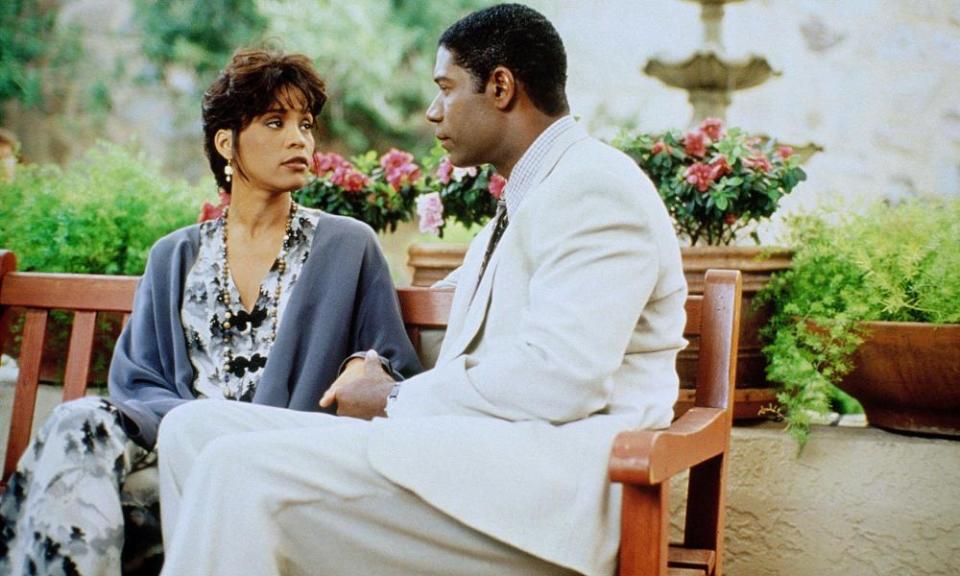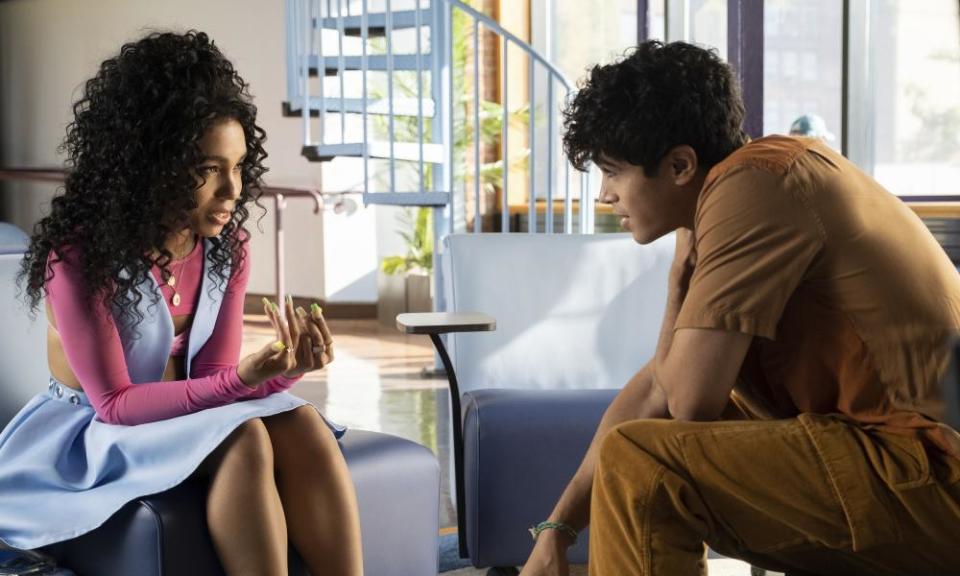Return of the romcom: the genre is thriving again – but with new values

Thirty-six new romcoms are coming out this year on film and streamed TV. That’s three a month! There’s a boxing romcom, a tennis romcom, one set in Taipei, one on a Croatian island, one in Vietnam and one with a fortune teller. There’s one in the back of a Berlin cab, and a gay romcom about the son of the US president and a “British Prince Henry”.
There’s a meet-the-parents story where it turns out the sets of parents, well, knew each other already. There’s one where the wedding party is taken hostage by gunmen; one where our heroine finds herself mysteriously attracted to her first love’s new wife. An interactive one where we get to make the heroine’s romantic and ethical choices. One proffering Céline Dion’s acting debut. A Wes Anderson one, set at a space cadet convention. And one called Sitting in Bars With Cake.
Industry reasons why romcoms are flourishing are pretty straightforward: while gargantuan megabuck superhero movies are massively expensive and complex, romcoms are quicker and cheaper to make, with little or no special effects, simple logistics and good opportunities for spin-offs. Actors like doing them, and they work well as streamers online.
To some, 36 may seem like enough. More than enough, even. But I’m not sure. Times are tough, and when times are tough more romantic comedies is exactly what we need. Like scarlet lipstick during the war (indeed, like romcoms during the war), they add a streak of hope, a blazon of defiant cheerfulness in a dingy world; the guarantee of a happy ending and a good shot of pure, unadulterated power of love.

Fred and Ginger, Cary Grant and Katharine Hepburn, Myrna Loy and William Powell saw our cinema-going ancestors through the 1930s, when the chicks were cool, screwball and good at their jobs, and the 1940s, when domestic stability was required. Doris and Rock, Tom and Meg, Jude and Cameron, Kate and Jack, Hugh and Julia (and Renée, and Andie) saw us through the last of the 20th century. And God knows we need romcoms now.
We can just watch the old ones when we want a trip to that special magical world where the transcendent and overwhelming value of romantic love above everything else is taken as given. But each generation needs its own in-jokes, its own music, clothes and reference points.
The tech by which the couple fails to communicate properly must move on, from the tiny boudoir telephones of the 1930s and the giant mobiles of the 1980s to the texts which now pop up on the big screen as the actors gaze down at their small screens. They must dance to different music, from big bands to Dansettes to Bluetooth. The capri pants, the big pants, the drag pants. The comedy must never be neglected, and if comedy isn’t taking the mick out of the society it grew from, it’s not doing its job.
As our stuff changes, we change too. Janis Ian told us decades ago that love is made for beauty queens, and in romcom world that stood for decades. Unless you were very funny, and could sing (Barbra Streisand and Cher could get away with not being blond), love was for slender straight white girls and square-jawed straight white boys. Now, that’s just not good enough.
Perhaps Hugh Grant began to break that mould when he persuaded Bridget Jones that he genuinely liked her neuroses, her big pants and her nine-stone body. Or – I mean, hang on – nine stone was a problem? Yes, it was. It was, apparently, fat. Plus, heaven forbid that Bridget should actually be capable of doing her job – describing her job, even – without falling over. Eat your heart out, Hildy Johnson, Rosalind Russell’s magnificent role as a star reporter wiping the floor with the men in His Girl Friday (1940).
Romcoms are problematic. We love them and we hate them – in itself such a romcom trope! Lives (mine, for example) have been shaped by trying and failing to reconcile being a rampant realistic feminist with being an insane romantic. In the old romcoms, only maids, waiters and musicians could be black, only gay best friends could be gay, only fat friends could be fat (until Bridget, who wasn’t fat anyway) and nobody was over 30.
American Pie (1999), the pit of sexist vanilla vulgarity, and movies like The Ugly Truth (2009) – which Stylist described as “a showcase for how all the charm of an opposites-attract film could be undone by stereotypical characters and a script full of jokes that hated women” – nearly killed the genre.
New romcoms are being made by people who grew up on the old ones and see their value but don’t share all their values
There were exceptions: Waiting to Exhale (1995) starred Whitney Houston, Angela Bassett, Loretta Devine and Lela Rochon, and Moonstruck (1987), in which, alongside Nicolas Cage and Cher at the opera, we are blessed with Olympia Dukakis and Vincent Gardenia in the geriatric subplot.
And there were the lastingly controversial: Love Actually (2003) (oh God) and the whiteness of Notting Hill (1999) the movie compared with Notting Hill the neighbourhood. We’ve always had to find a way to love what we love about them and complain loudly about what we don’t.
The new romcoms are being made by people who grew up on the old ones and see their value but don’t necessarily share all their values or their social context. Post #BlackLivesMatter and #MeToo, films such as Failure to Launch (2006), Pretty Woman (1990) or While You Were Sleeping (1995) get stopped and interrogated.

Very dodgy premises based on power and consent used to slide gaily by in the name of entertainment. No more. Tricking the family of a comatose man into believing you’re his fiancee then marrying his brother? That’s not a romcom, it’s psychopathic.
Attitudinal changes may seem to limit the scope. Potential pitfalls around identity and gender politics make lots of old romance tropes tricky: how can, for example, an opposites-attract situation resolve into misty romantic union, how can two hearts beat as one and characters be transformed by love, when people are so strongly sworn to a particular tribe or identity?
But other, fruitful, areas are opening up. Since Crazy Rich Asians (2018), we’re seeing on western screens that white western society is not the only one obsessed with coupledom and the particular vision of order-from-chaos that the romcom represents.
Since Crazy Rich Asians we’re seeing that white western society isn’t the only one obsessed with coupledom
Now, not all princesses are Julia Roberts and not every prince has floppy hair. Anything’s Possible (2022) is directed by Billy Porter and features a cis Iranian hero and a black trans heroine. In Rye Lane (2023), directed by Raine Allen-Miller, starring David Jonsson and Vivian Oparah, the “meet-cute” is in a gender-neutral public loo, and from that to the endearing trope about not trusting people who don’t wave back to tourists on boats, it’s charm personified – personified in young black Londoners in Peckham.
What’s Love Got To Do With It? (2022), directed by Shekhar Kapur, with a screenplay by Jemima Khan, is about a British Pakistani guy, a Pakistani girl and a white British girl trying to make a documentary about their arranged marriage. “Love contractually,” she quips. As Jane Austen knew, social rules and boundaries give comedy its framework. Western society is shifting its rules fast and perilously at the moment.

It would be nice to think that this widening social context also widens the remit of the romcom, but to be honest the song remains the same: All By Myself versus Your Love Is King. On one level, the new territories just give more space for romcoms to tell us again that being alone is a category error, that the social order’s in danger until you’re happily and sexually coupled up.
From Jane Austen to Bridget Jones, Cinderella to Midsummer Night’s Dream, Barbie to Heartstopper, the message comes through clear and conventional: the smug marrieds know that you – Cinders, the Prince, Demetrius, Hermia, Lysander, Helena, Mr Darcy, Elizabeth, you, me, everyone – must be in want of The One. That’s my harsh view.
But as Delia Ephron, sister and writing partner of the more famous Nora, said in Vanity Fair: “When you’re already in love, the only place you ever fall in love again is in the movies.”
And at heart that’s why we come back. We love to feel the love again and again. And now more of us can see ourselves up there on the screen, mixed feelings and all.
Louisa Young’s romcom novel Twelve Months and a Day is out now (Borough Press)

 Yahoo Movies
Yahoo Movies 
